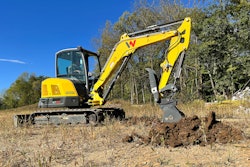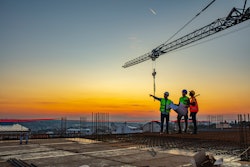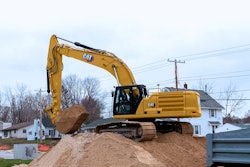
Construction contractors are maintaining a strong sense of good profitability and growth in 2023 based on a current slate of seemingly full backlogs.
Associated Builders and Contractors Chief Economist Anirban Basu suggested during his 2023 Q1 construction economic update and forecast that the contractors simply “can’t handle the truth,” as Jack Nicholson’s character once said in the film A Few Good Men.
"The war on inflation is ongoing; it's not yet won," Basu said. "I think recession conditions will prevail at some point in the next 12 months. I think by the third or fourth quarter of this year, we will be in recession, you will see more deterioration in the data going forward."
Presenting his analysis of current economic data, Basu acknowledged that there is enough data to support any perspective. He maintains his belief of an impending recession and more difficult times ahead based on his analysis of leading economic indicators.
"The cost of capital is rising, and that's a threat to construction,” he said. “We are seeing a fraying of the edges.”
There are many challenges facing the U.S. construction industry, but the good news is, demand for construction services has remained high. Despite the economic indicators the average contractor remains confident that profitability will remain high during the next six months.
Across the industry, there is little indication that backlogs are dissipating. A survey during Basu’s presentation and ABC’s construction backlog indicator each bear out that contractors have stable backlogs with business lined up deep into 2023.
"A lot of the growth is because it's costing more to deliver construction service, not because the industry is supplying more service," Basu said. "Many contractors are telling me their operating capacity that they can't run anymore work."
 Associated Builders and Contractors
Associated Builders and Contractors
Manufacturing, commercial, healthcare and public infrastructure-related construction spending is up more than 10% from February 2020. Conversely, lodging, office, educational and power segments have continued to decline.
"I think the demand for new warehouse space will be softening compared to what it has been,” he said. “It's the office space, lodging, and shopping center construction segments, that's where I do see weakness.”
Basu labels office space as one of the weakest points of the construction industry and as a threat to banks.
“A lot of these office buildings are vacant, and some owners now are increasingly missing their debt service payments so they're sitting on bank balance sheets as a potential liability, and if we have a significant downturn in the office market it translates to a financial situation that could further tighten credit,” he said.
Despite the contractors’ continued optimism to chase demand, the ABC economist maintains his recession forecast and advises caution.
“We're in a stasis period. Things have been strong from a demand perspective for construction services and contractors have been busy,” Basu said. “It’s not a bad time to raise some cash and think about your staffing model.”
Most contractors continue to maintain that the labor shortage is their number one challenge, so changing their staffing model has not been up for discussion.
According to a survey taken during Basu’s webinar presentation, 20% of respondents cited the supply chain as a significant challenge.
The ABC economist said the Federal Reserve is fighting inflation in what is now a weakening economy.
“There's been some disinflation, but still, it is the case that inflation remains well above the Federal Reserve's target,” he said. “The combatting of excess inflation persists.”
The unemployment rate nationally is 3.6%, identical to what it was when the Federal Reserve started raising rates in March 2022. Despite all the efforts to cool the economy, many employers continue to seek more workers. Federal data shows that there are approximately 1.7 job openings for every unemployed American.
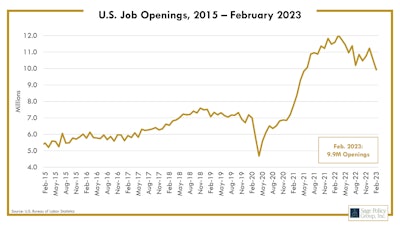 The unemployment rate nationally is 3.6%, identical to what it was when the Federal Reserve started raising rates in March 2022. There are approximately 1.7 job openings for every unemployed American.Associated Builders and Contractors
The unemployment rate nationally is 3.6%, identical to what it was when the Federal Reserve started raising rates in March 2022. There are approximately 1.7 job openings for every unemployed American.Associated Builders and Contractors
“You want a job in America, there's one waiting for you; in fact, there are close to two,” Basu said. “That is inflationary, which means the Federal Reserve looks at this and says it's still too good out there for prospective employees.”
Under those conditions, he categorizes the economy as being overheated, still growing and still generating inflation.
Like the job market, construction material prices continue to be a measure of inflation. Over the past three years, there was a point where fuel costs rose more than 20% on a year-over-year basis.
Basu noted that despite declines in several categories, there remains an abundance of inflation in concrete products, nonferrous wire and cable, plumbing fixtures, prepared asphalt and roofing products, and fabricated metals.
“The cost of goods and services continues in general to rise,” he said.
Nonetheless, the construction industry stands tall and remains optimistic. Or maybe not. There appeared to be one glimmer of hesitation. Approximately 10% of the webinar attendees indicated financing as a major issue.
Basu attributed this to the recent failures of Silicon Valley Bank and Signature Bank. Although not directly related to borrowing and loans, he feels those bank failures could make it more likely that a recession is coming.
"The failures of those banks, as you know was not driven by defaults on loans,” Basu said. "It was driven by poor treasury management and being exposed on the balance sheet to interest rate sensitive assets. When the Federal Reserve increased interest rates, some of those bonds on their balance sheets lost value, and eventually that spawned panic and runs on the banks and so on."
 Among the indicators of a pending recession is the treasury yield curve. Typically, the 10-year yield would surpass the one-year yield and currently, the 10-year is noticeably below that of the one-year.Associated Builders and Contractors
Among the indicators of a pending recession is the treasury yield curve. Typically, the 10-year yield would surpass the one-year yield and currently, the 10-year is noticeably below that of the one-year.Associated Builders and Contractors
The general belief within the construction industry is that business will continue to remain strong despite the Federal Reserve's micro-banking policy and the recent bank failures.
“As people in construction we don't care about treasury yields, we care about what banks are offering to developers and other purchase of construction services as their cost of capital,” the ABC economist said.
U.S. Treasury yields have been coming down because people are getting scared and putting their money into safer assets. Talking to bankers, Basu has found that they are not reducing their interest rates and if anything, are keeping them high due to increasing concern about delinquency defaults.
“It's often said that the Federal Reserve raises rates until something breaks, well, something is breaking, and the issue here is the availability of bank credits,” he said.
Anecdotally, Basu shared that he had a recent conversation with a major general contractor who said he had endured subcontractor defaults and even one project owner that could not line up equity to keep a project going and stopped work on a project.
From his perspective, the ABC economist said a genuine banking crisis could be the worst-case scenario for the construction industry.
“We don't know what we don't know,” he said. “In recent weeks, markets have been rallying and regional banks have been doing better. You don't know what you don't know because these bank balance sheets are black boxes to us.”
Before failing Silicon Valley Bank appeared financially healthy. Basu suggested that the next layer of bank failures could be about delinquencies, defaults, and issues associated with the U.S. office market.
"If you have a genuine credit crunch and private financing disappears or dissipates meaningfully, that's the worst-case scenario for construction," he said. "If the financing falters, then all of a sudden those projects on those backlogs disappear."
Also, he noted that between the ongoing interest rate increases and supply chain challenges, it is the interest rate increases that pose the greater threat. Basu said developers will say what takes a project off the table is that cost of capital is going up too much that the project simply doesn’t work financially.
He said he fears that at some point demand starts to dissipate quite quickly and backlogs start to falter and simultaneously, many contractors take on additional costs, thinking that they're going to be in a higher mark than they end up being in and that's what creates the seeds of some challenging times.
“For an industry that depends heavily upon access to credit and the cost of that credit, and equity, the cost of capital generally, for project financing, for instance, that matters,” Basu said.
From a construction standpoint, he suggested that the single-family housing market is already in recession.
In January 2022, the average 30-year fixed mortgage rate was 3.2%, a year later, they are at 6.32%. However, for certain generations, 6.32% is nothing, having paid 15% or more for their respective first mortgages.
“For those people that 6.32% might not seem especially onerous, but for millennials and Generation Z it is preposterously high rates of mortgage rates,” Basu said. “The whole purchasing process often begins with a mortgage application, so unless you're a private equity firm, typically you borrow money to purchase a home and so mortgage application is an important part of the process and is a signal that people intend to transact.”
He said the U.S. mortgage loan application composite index is down about 60% over the past year. Basu asserts this is an indication that the single-family housing market is in recession as sellers reduce their asking prices to accommodate the higher interest rates.
“I think that that process will continue through the spring selling season,” he said. Furthering his analysis of the data is the overall reduction of residential building permits due to the reduced demand.
Conversely, still needing a place to live, the younger generations are turning to multi-family options.
"All things being equal higher mortgage rates are good for the multifamily market," Basu said, noting that the segment of the construction market should be reasonably strong going forward.
“I would expect some weakness there because those apartment projects may not receive financing, given the credit conditions are piling up but still people need a place to live and there's a deficit of housing in this country,” he said.
For non-residential construction, the Architecture Billings Index is often a good indication of the current market. If the architects are busy, then the construction contractors are not far behind. Unfortunately, over the past five months as interest rates have risen, the ABI has fallen.
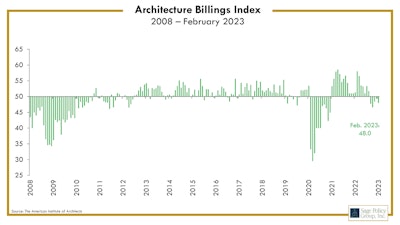 Associated Builders and Contractors
Associated Builders and Contractors
Basu suggested that the current volume of construction work is not necessarily a function of economic growth but is a function of the current economic transformation.
"On the one hand, I'm saying recession is coming on the other I recognize that there is this transformation transpiring in America, associated with these mega projects," Basu said, citing the wave of mega industrial projects associated with computer chip, battery, electric vehicle, and inputs into alternative energies being constructed.
“That foreshadows a weakening, at least in certain construction segments,” he said. “Some contractors will be very busy and will have more work than they know what to do with and other contractors will be struggling to find work in an environment characterized by a weaker office construction market if they're not aligned to geographies, in which these mega projects are transpiring,” he said. “What I think you're going to see over the next few years is greater disparity in contractor performance across the industry.”
The ABC economist suggests that the disparity in performance could usher forth multiple mergers and acquisitions over the next two or three years as weaker performers, through no fault of their own is purchased or merged with players who have benefited from the mega-projects.
"I think we're going to see a fair amount of consolidation in the U.S. construction industry going forward and one of the factors is we have a lot of construction firm owners that are in their 60 and if their kids are not going to take over the business, they need to sell it. I think there are going to be lots of buyers out there looking for that capacity."



